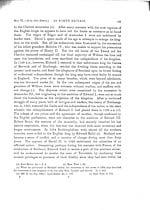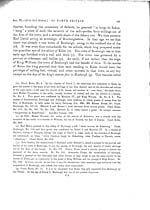Volume 3
(117) Page 106
Download files
Individual page:
Thumbnail gallery: Grid view | List view

106 allegiance (f). The truce which gave dear-bought liberty to David II. in 1357 did not restore Roxburghshire to its ancient obedience (g). By a treaty for settling border disputes, which was held at Roxburgh within the church of the Minor Friars during the same year, it was agreed that all lands should remain as they were then possessed (h). But the time came at length when the borders were restored to their old limits, and the men of Teviotdale were to return to their natural connection (i). Yet the people on the marches between the two kingdoms continued in a state of conflict even after the accession of King James had united the sister, yet adverse kingdoms (k). From inquiries with regard to the limits of the two kingdoms and the state of Teviotdale, the next objects of our attention are the castle and town of Roxburgh; and they seem both to have existed during Saxon times and during the Scottish period of the North-British annals. The castle and town appear plainly to have been appropriate portions of Earl David's apanage, and his favourite residence after his succession as king (l). By Earl David's (f) In 1356, Edward III. granted a kind of charter to the men of Tevydale. It recited their fidelity; it granted them all the liberties, which they had enjoyed, during the reign of Alexander III., with their old privileges, within the town of Berwick. Ib. v. 854. In 1359, a similar grant was made by the same prince to the men of Liddesdale. Ayloffe's Calend. 222. (g) Bym. v. 846�854 ; Ib. vi. 426-7. Edward III. retained within his artful grasp the castles of Roxburgh, Jedburgh, and Lochmaben. (A) Id. (i) An ordinance issued from the Scottish council, in April 1385 ; directing, that the men of Teviot- dale, who had come lately from the allegiance of the king of England to the allegiance of the king of Scotland, should retain their possessions, but should be required to show their title deeds. MS. Paper Office, which has been transferred to the Register House at Edinburgh. (k) In 1620, King James issued a proclamation "contra tenentes seditiosos,'' which recited the inconvenience of tenant rights on the Scottish borders, or customary right of holding, in consideration of services on the borders ; and which decreed, that no estate should pass, in future, except by indenture. Rym. Foed. xvii. 249. (I) Many of the charters of David I, Malcolm IV., of William the Lion, and the two Alexanders, his son and grandson, were dated in the castle of Roxburgh ; as we may see in the churtularies. and in the Diplomata Scotiase, pl. 22�24. David I. granted to the church of St. John, within the castle of Roxburgh, a carucate of his domestic lands in Roxburgh, a toft with its pertinents, and a piece of land below the castle, with the oblations of those who resided within it, and also a part of his own oblations when he or his family should reside in the castle; in the same manner as one of his own chaplains ought to have. He gave also to this church of St. John the tithes of his underwood, and a tenth part "de sepo occisionis," by him in Teviotdale. Chart. Glasgow, No. 205. This charter of the munificent David was confirmed his son Henry, and by his grandson William. Ib. 2G7�9. Those charters not only show the residence of David I., but carry the mind back to the manners of ages that are long passed.
Set display mode to:
![]() Universal Viewer |
Universal Viewer | ![]() Mirador |
Large image | Transcription
Mirador |
Large image | Transcription
Images and transcriptions on this page, including medium image downloads, may be used under the Creative Commons Attribution 4.0 International Licence unless otherwise stated. ![]()
| Caledonia, or, An account, historical and topographic of North Britain from the most ancient to the present times > Volume 3 > (117) Page 106 |
|---|
| Permanent URL | https://digital.nls.uk/74528308 |
|---|---|
| Description | Vol. III. |
|---|---|
| Attribution and copyright: |
|

